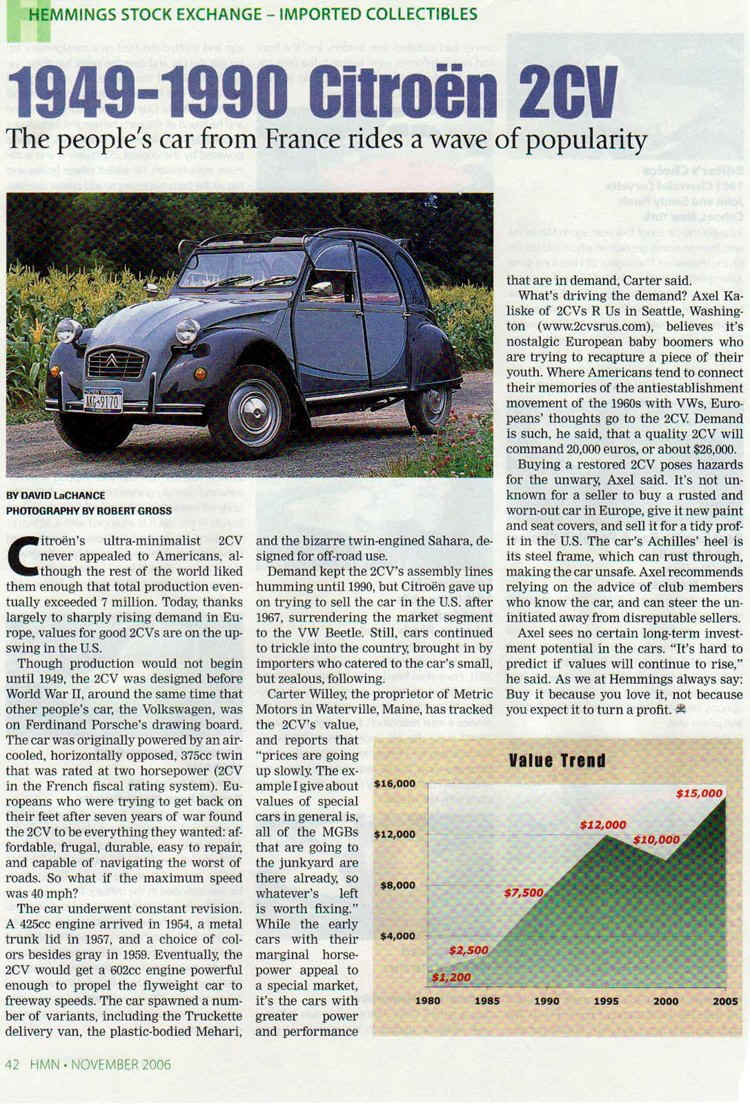Article uit Hemmings stock exchange, November 2006.
 |
Article uit Hemmings stock exchange, November 2006.
 |
| Citroen's ultra-minimalist
2CV never appealed to Americans although the rest of the world liked them enough that
total production eventually exceeded 7 million. Today thanks largely to sharply rising
demand in Europe values for good 2CV are on the up-swing in the U.S. Though production
would not begin until 1949, the 2CV was designed before World War II around the same time
that other people's (in the Volkswagen. was on Ferdinand Porsche's drawing board.) The car was originally powered by an aircooled, horizontally opposed, 375cc twin that was rated at two horsepower (in the French fiscal rating system). Europeans who were trying to get back on their feet after seven years of war found the 2CV to be everything they wanted; affordable, frugal, durable, easy to repair and capable of navigating the worst of roads. So what if the maximum speed was 40 mph? The car underwent constant revision. A 425cc engine arrived in 1954, a metal trunk lid in 1957, and a choice of colors besides gray in 1959. Eventually the 2CV would get a 602cc engine power enough to propel the flyweight car to freeway speeds. The car spawned a number of variants, including the truckers delivery van, the plastic-bodied Mehari, and the bizarre twin-engined Sahara. designed for off-road use. Demand kept the 2CV's assembly lines humming until 1990 but Citroen gave up on trying to sell the car in the U.S. After 1967, surrendering the market segment to the VW Beetle. Still, cars continued to trickle into the country brought in by importers who catered to the car's small, but zealous, following. Carter Willey the proprietor of Metric Motors in Waterville.Maine, has tracked the 2CV's value, and reports that "prices are going up slowly. The example I give about values of special cars in general all of the MGBS that am going to the junkyard are there already, so whatever's left is worth fixing", While the early cars with their marginal horsepower appeal to a special market it's the cars with greater power and performance that are in demands Carter said. What's driving the demand? Axel Kaliske of 2CVs R Us in Seattle, Washington (www.2cvsrus.com), believes it's nostalgic European baby boomers who are trying to recapture a piece of their youth. Where Americans tend to connect their memories of the antiestablishment movement of the 1960s with VWs, Europeans' thoughts go to the 2CV. Demand is such, he said, that a quality 2CV will command 20,000| Euros, or about $26.000. Buying a restored 2CV poses hazards for the unwary Axel said. It's not unknown for a seller to buy a rusted and worn-out car| in Europe, give it new paint and seat covers, and did it for a tidy profit in the US The car's Achilles' heel is its steel frame. which can rust through, making the car unsafe. Axel recommends relying on the advice of club members who know the car; and can steer the uninitiated away from disreputable sellers. Axel sees no certain long-term investment potential in the cars (It's hard to predict if values will continue to rise he said. As we at Hemmings always say: Buy it because you love it, not value you expect it to turn a profit HMN - November 2006 |
More converted 2cv pages Convertibles - My own car - How to build one - Wrecks - Gonna move ? - Truckettes Racing ducks - Custom fronts - Specials - Fun cars - 2 CV Landau lets |

In 45 jaar heb ik heel wat 2pk onderdelen verzameld. 2cv Parts for sale |
| My entirely scanned car brochures about Citroen and Panhard Dit zijn al mijn volledig ingescande Citroen en Panhard folders |
more/meer sites of me on the wwweb |
||
CitroŽn 2cv's |
|||